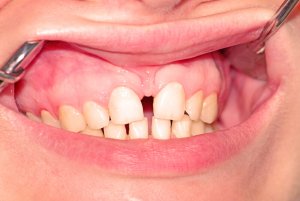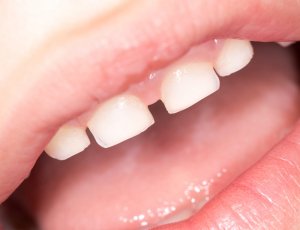Diastema is a fancy word for having a gap in your teeth. There are various types of diastema, and they have a number of causes.
You don’t always have to fix a gap in your teeth, especially if it’s only for aesthetic concerns, but if you have diastema as part of more severe malocclusion, then you may need treatment with orthodontics.
In this article, we’ll cover the following:
- Types of diastema (midline and mandibular)
- Diastema treatment
- How to close a gap without braces
- Before and after gap teeth
Keep reading to learn all you need to know about diastema.
What is diastema?
Diastema is a gap between teeth. It’s most noticeable with gappy front teeth, but gaps between teeth can occur anywhere in the mouth — top and bottom arches and molars.


According to this report in the Journal of the American Dental Association about maxillary midline diastema, between 1.6% and 25.4% of people have a general or midline diastema.
Types of diastema
There are two main types of diastema:
- Midline diastema: This is when you have a gap between your 2 upper or lower front teeth
- Mandibular diastema: This is a gap between any lower teeth (along the jaw)
Diastema treatment
There are various ways to close gaps in teeth, which you can read about below.
Braces for gap teeth
Braces can be used to adjust the position of diastema teeth and close gaps in the mouth.
Depending on the severity of your diastema, there are various types of braces for gap teeth that you can use.
Larger gaps usually require treatment with traditional braces, whereas smaller gaps can be closed with clear aligners or invisible braces.
As an aside—you may need braces to close gaps in your front teeth, but spacers for teeth around your molars in the back to make more space for teeth movement!
In the video below, an orthodontist explains in greater depth what causes diastema, and how orthodontics can help:
If you’re interested in clear aligners or invisible braces for gap teeth, have a look at some of the top brands available to see if one could work for you:
- Most affordable options
- Single and dual arch, day and night options
- Convenient AlignerTracker app
- Free teeth whitening
Aligner32 offers a convenient and affordable way for individuals to straighten their teeth using custom-fit clear aligners. Their service is designed for at-home use, allowing customers to avoid frequent orthodontist visits while still achieving professional-grade results.
Aligner32 provides two main treatment plans tailored to suit different needs:
- All-Day Plan: The All-Day Plan requires 22 hours of daily wear and offers faster results, with treatment lasting between 4 to 6 months.
- Night Wear Plan: The Night Wear Plan is ideal for those who prefer a more flexible routine, requiring just 10 hours of daily wear, typically at night, with a treatment duration of 6 to 8 months.
Both plans are designed to treat a range of orthodontic issues, including crowding, spacing, overbites, underbites, and crossbites.
With affordability in mind, Aligner32’s clear aligners are significantly less expensive than traditional braces, which can cost between $5,000 to $8,000. Customers can also use flexible payment plans, making it easier to manage the cost.
Additionally, Aligner32 offers a free teeth whitening kit with their aligner packages, making the treatment even more appealing. The company emphasizes comfort, convenience, and professional care, making it a popular choice for those seeking a better smile without the high costs and hassle of conventional orthodontic treatments.
- Complete treatment 100% remotely
- Amazing customer service
- Nighttime-only option
- $1,495 or $55/month
NewSmile aligners are made from the clearest Essix plastic and come with a daytime or nighttime-only option to suit you. For just $1,495 you’ll receive everything you need to straighten and whiten your teeth – and maintain your new smile:
- Home impression kit
- Full aligner treatment
- Free whitening
- First set of retainers
- A full refund if you’re not a good fit
NewSmile goes above and beyond to provide a great experience to all their customers, beginning with a live video call to help you with your teeth impressions. Mail these back, and they’ll send a 3D Treatment Preview for you to approve before going ahead.
- Smileie Pro offers hybrid treatment!
- Single-arch treatment option
- Nighttime aligners available
- Free refinements & 2 sets of retainers
- $699 (single-arch) or $999 (dual-arch)
Smileie’s aligner treatment is not only affordable, but flexible too. You have the option of Smileie Pro, which is hybrid treatment that involves in-office visits with a dentist.
That means more accurate, safer and effective treatment or a wider variety of cases.
But you can also opt for single-arch treatment for just your top or bottom teeth, as well as nighttime-only treatment. And whichever package you choose, monthly payments are available.
On top of this, Smileie offers a 100% satisfaction guarantee which includes free refinements if needed. Their aligners are made in the US and treatment takes 4-6 months on average.
Get Smileie Pro for just $1499, or —
Get the best discount on the standard plan, with 100% remote treatment, when you purchase your aligner package up-front, including:
- Home impression kit
- Teeth whitening kit
- Two sets of retainers
- A full refund if you’re not a good candidate
Packages start at $699 for single-arch treatment. Click below to check for current discounts!
- Complete treatment 100% remotely
- 4-6 month average treatment time
- Nighttime-only option
- $770 or $64/month
If you’re looking for the best value aligner package, here it is! For just $895 you’ll get:
- Impression kit
- Full aligner treatment course
- Free teeth whitening kit
- Your first set of retainers
In short, everything needed to straighten your teeth remotely and keep them looking great, with a full money-back guarantee if you’re not a suitable candidate.
This low price doesn’t mean you’re compromising on quality of care, though. ALIGNERCO just choose not to put so much into marketing, and they pass on the savings to their customers. They are also known for their responsive and helpful customer care, which is important when you’re doing things from home.
Nighttime-only aligners are also available for anyone who doesn’t want to wear aligners during the day.
There is a possibility that your diastema will reopen after orthodontic treatment if other factors like frenum anomaly or muscular habits have not been addressed.
How to close a gap without braces
Braces and aligners aren’t the only ways to fill gaps in teeth. If you want to close gaps in teeth without using other techniques, two other options are veneers and composite bonding.
For children, a gap noticeable between front teeth isn’t generally harmful and will usually close when their permanent teeth come in. Teens and adults may choose to have a diastema closed for cosmetic reasons. Treatment options include both orthodontic closure or restorative treatment to widen the teeth, like porcelain veneers.
A diastema between posterior teeth can be a food trap, and aside from being annoying, could lead to bone loss or tooth decay. Some spaces may open as a result of missing posterior teeth putting excess forces on the remaining teeth. Finally, underlying periodontal disease is a common reason for spaces developing.
Often, however, a diastema is mainly a cosmetic issue and each patient will have to decide whether it’s something they can live with or not.
Dr. Greg Nalchajian, Nalchajian Orthodontics
Porcelain veneers


A porcelain veneer is a thin cover that fits on top of your natural teeth to alter the shape and/or color. Fixing a small diastema with veneers is quite straightforward, but this treatment is only suitable for adults.
You can read more about teeth veneers.
Diastema closure with composite bonding
With diastema bonding, a composite material is applied directly to the teeth – no lab work required. The dentist builds up and shapes the composite to give the desired appearance.
You can read more about the procedure for tooth bonding here, and composite restorative procedures as an effective and affordable gap tooth treatment in this study here.
Veneers vs. bonding for a diastema
The table below summarises the two main options for treating a diastema without braces, including costs:
| | Porcelain Veneers | Composite Bonding |
| What does it involve? | A porcelain cover is applied to the teeth, made slightly wider than the teeth to fill in a gap | A composite material is added directly to the teeth to build them up, increasing the size of the teeth to fill the gap |
| How long does it take? | 2 visits – one consultation and another 1-3 weeks later for fitting | Can be done in one visit |
| What does it cost? | $500 – $2,500 per tooth | $250 – $1,200 per tooth |
| Pros? | Long lasting and hard wearing | Fast and lower cost |
| Cons? | Takes away some healthy tooth, takes two dentist visits, only works for small gaps | Will need touching up – bonding lasts up to 5 years, only works for small gaps |
These treatments should not be used to mask severely misaligned teeth that require orthodontic treatment.
How much does a diastema closure cost?
Diastema closure costs anywhere from $200 to $13,000, depending on the type of treatment you choose. On the low end is composite bonding, and on the higher end, veneers and braces.
Filling gaps between teeth is unlikely to be considered a medical necessity, and therefore state-funded insurance usually doesn’t cover diastema closure costs in the US. Although your private insurance might.


Children and adults with severe cases of teeth spacing, perhaps as a result of hypodontia, or congenitally missing teeth, may be eligible for braces and then dentures or dental bridges to fill the gaps. Medicaid and CHIP also covers treatment for periodontitis, which may be the cause of gaps between teeth. Read more about dental services covered by Medicaid.
There are less expensive options like Snap-on veneers and Instasmile, but you get what you pay for, as you can see in our Instasmile reviews.
Conclusion
A diastema, or gap in your teeth, is generally not a medical concern in itself. But, there can be underlying reasons you have gaps in between your front teeth, or between other teeth, so it’s best to see a dentist for a proper assessment.
Closing gaps is reasonably straightforward and traditional braces aren’t always necessary. People with gaps in their front teeth, in particular, can get great results with removable aligner braces like Byte aligners, NewSmile aligners, Candid aligners or ALIGNERCO clear aligners. You can read more about the best invisible braces in our separate article.
FAQs
Do braces close gaps in teeth?
Yes. Especially if your diastema is more severe, braces to close a gap in teeth may be the only option available to you. If you require slight correction, at-home clear aligners are a good solution.
What can you do about space between front teeth?
If you have space in the front of your mouth, you can use orthodontic treatment to close the front teeth gap. Since this may only be a minor correction, you can use Invisalign to close gaps. In this case, you may also be able to close a gap in your teeth at home with clear aligners.
Can a retainer fix gaps in teeth?
Teeth retainers are limited in what movement they can achieve and don’t deliver quick results. The normal course of action would be to have permanent or removable braces. These would correct the diastema and then you would wear a retainer to maintain the new alignment.
Removable aligner braces are probably the closest option to a retainer, since they aren’t attached to your teeth like traditional braces. They are also far less noticeable than a metal wire retainer.
Are gaps in baby teeth normal?


Yes, gaps are normal in baby teeth. At this age, the jaw is still developing and may progress faster than teeth growth. It’s also natural for there to be gaps with the first adult teeth.
I have gaps in my teeth after braces, what can I do?
Braces are designed to correct the position of your teeth and give you a properly aligned smile. If you aren’t happy with the results of your treatment, talk to the dentist who treated you. Do make sure that you wear your retainers as instructed after your treatment; this helps ensure your teeth stay in the correct position.
Does flossing create gaps in teeth?
There isn’t any reason that normal flossing would cause gaps to appear between your teeth. It is possible that you are catching your gums as you floss between your teeth. This could cause them to start to recede.
A water flosser also makes it easier to clean gaps between teeth.
How can I fix small gaps in teeth?
If you do not have severe diastema but are worried about the appearance of your smile, you may be able to get veneers to hide the gaps, although they won’t actually fix the problem.
How long does Invisalign take to close a gap?
If your tooth gap is relatively small, Invisalign can take as little a six months. For minor treatments, you may be able to use Invisalign Express which costs less than Invisalign Full. If the gap in your teeth is quite large, or you have additional malocclusion problems that need to be fixed, your Invisalign treatment could take anywhere from 12 to 18 months.
JADA: Treating a maxillary midline diastema in adult patients. Consulted 22nd June 2019.
ResearchGate: A clinical case report on the treatment of mandibular diastema, associated with tongue interposition and tongue thrust swallow. Consulted 22nd June 2019.
Cureus.com: Bridging Gaps: A Comparative Approach to Managing Midline Diastema. Consulted 20th March 2023.
JADA: Treating a maxillary midline diastema in adult patients. Consulted 22nd June 2019.
ResearchGate: A clinical case report on the treatment of mandibular diastema, associated with tongue interposition and tongue thrust swallow. Consulted 22nd June 2019.
Cureus.com: Bridging Gaps: A Comparative Approach to Managing Midline Diastema. Consulted 20th March 2023.







